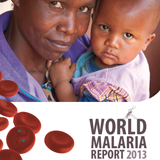View Resource The World Malaria Report 2013 summarizes information received from malaria-endemic countries and other sources, and updates the analyses presented in the 2012 report. It highlights the progress made towards the global malaria targets set for 2015, and describes current challenges for global malaria control and elimination.
Since 2000, a tremendous expansion in the financing and coverage of malaria control programmes has led to a wide-scale reduction in malaria incidence and mortality. Based on reported data, 59 out of 103 countries that had ongoing malaria transmission in 2000 are meeting the Millennium Development Goal (MDG) target of reversing the incidence of malaria. Of these, 52 are on track to meet Roll Back Malaria (RBM) and World Health
Assembly targets of reducing malaria case incidence rates by 75% by 2015, including 8 countries of the WHO African Region. In 41 countries it is not possible to assess trends using reported data because of inconsistencies in the completeness of reporting
over time, changes in diagnostic practice or health-service use. For these countries, which accounted for 80% of cases in 2000, inferences about malaria trends need to be based on estimates of the malaria case incidence and mortality rates.
Worldwide, between 2000 and 2012, estimated malaria mortality rates fell by 45% in all age groups and by 51% in children under 5 years of age. If the annual rate of decrease that has occurred over the past 12 years is maintained, then malaria mortality rates are projected to decrease by 56% in all ages, and by 63% in children under 5 years of age by 2015; this represents substantial progress towards the World Health Assembly target of reducing malaria mortality rates by 75% by 2015.
Modelling suggests that an estimated 3.3 million malaria deaths were averted between 2001 and 2012, and that 69% of these lives saved were in the 10 countries with the highest malaria burden in 2000; thus, progress is being made where it matters most. About 3 million (90%) of the deaths averted between 2001 and 2012 are estimated to be in children under 5 years of age in sub-Saharan Africa. These account for 20% of the 15 million child deaths that are estimated to have been averted in sub- Saharan Africa since 2000 through overall reductions in child mortality rates. Thus, decreases in malaria deaths have contributed substantially to progress towards achieving the target for MDG 4, which is to reduce, by two thirds, the under-5 mortality rate between 1990 and 2015.
Nevertheless, between 2011 and 2012, the pace of decrease in estimated malaria mortality rates slowed. This slowing is partly because the model that is used to estimate malaria deaths in children under 5 years of age in Africa uses insecticide-treated mosquito net (ITN) coverage as an input, and ITN coverage flattened in 2011–2012 following decreases in funding for malaria control in 2011. In 2012, financing of malaria programmes was estimated to be less than half of the estimated US$ 5.1 billion required globally. Thus, millions of people at risk of malaria still do not have access to interventions such as an ITN, indoor residual spraying (IRS), diagnostic testing and artemisinin-based combination therapies (ACTs). As a result, an estimated 207 million cases (uncertainty interval, 135–287 million) and 627 000 malaria deaths (uncertainty interval, 473 000–789 000) are estimated to have occurred in 2012. There is an urgent need to increase funding for malaria control and to expand programme coverage, in order to meet international targets for reducing malaria cases and deaths.
- Foreword and Executive Summary available in English, French and Spanish
